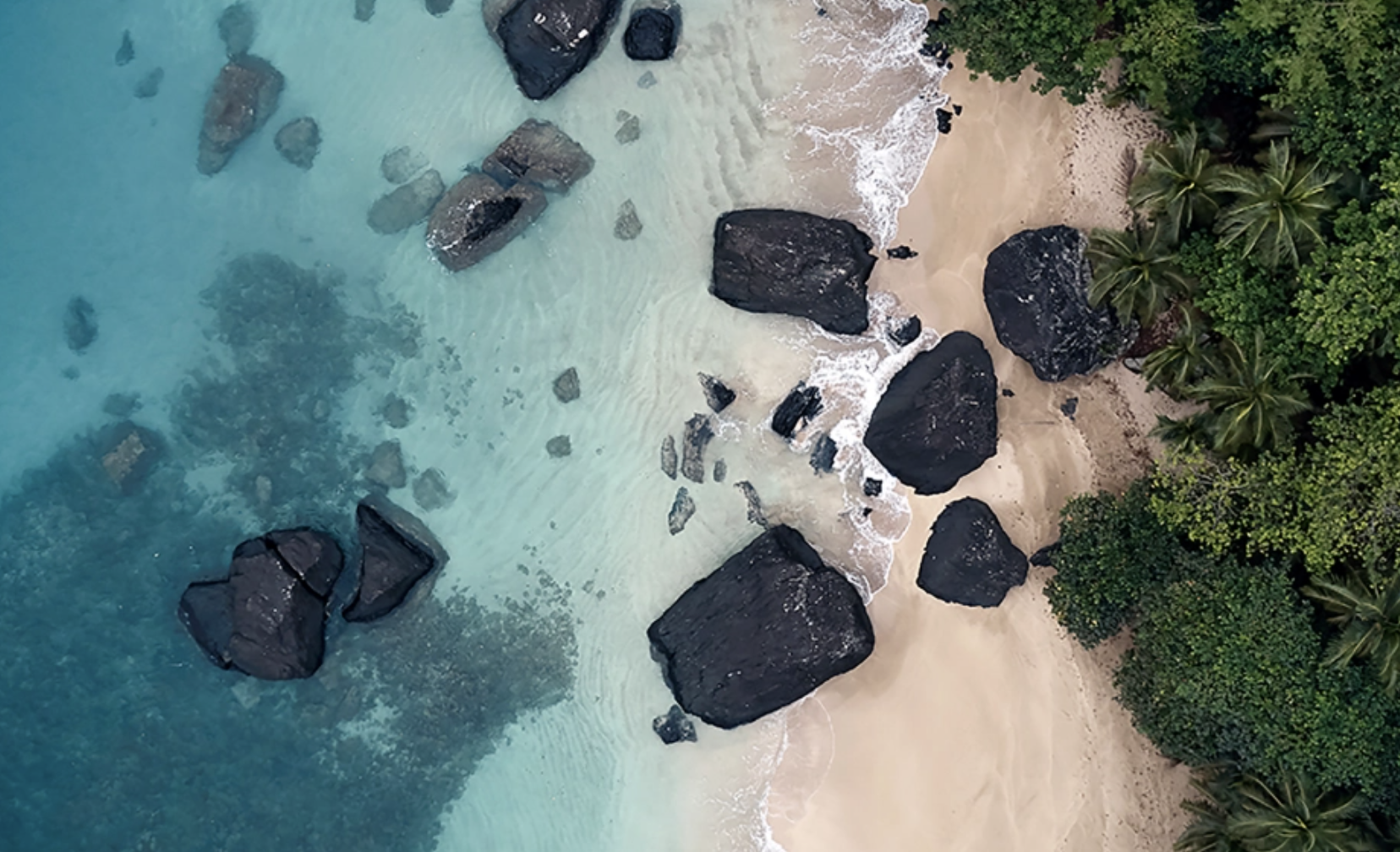
The Tiny West African Tropical Getaway You’ve Never Heard Of
The island nation of São Tomé e Príncipe is aiming to become the fashionable getaway of choice for the worldly, eco-conscious traveller.
Related articles
Landing at the airport on the tiny West African island of Príncipe, the plane seems to skim the top of the dense jungle canopy, almost like a pebble skipping the surface of the water. Runway and shack-like terminal aside, there’s barely any evidence of human intrusion into the Jurassic Park–like landscape. Later, as you roam through that jungle on foot, the sensation of time warping is only magnified. The strange caws and yelps that ricochet round the canopy, evidence of the dozens of unique bird species here, could just as easily be a dinosaur’s, out of place and time.
It’s an impression that also hit Mark Shuttleworth when he first touched down here in his Bombardier jet over a decade ago, casting around with his pilot for a handy pit stop between his two permanent bases, the Isle of Man in the Irish Sea and Cape Town, South Africa, where he grew up. “I was looking for an out-of-the-way place where I could essentially just enjoy being at ease with nature in Africa,” he recalls. Though he admits, “I was almost going to write this off,” his mind changed, quickly, after disembarking on Príncipe. “My overwhelming impression was that this was both extraordinary and extraordinarily fragile. And I wanted to take the opportunity to do something with the people there that gives them something unique in the world, forever.”
That impromptu mission—he even showed up at the president’s office unannounced, without an introduction, seeking a meeting—has become a driving force in Shuttleworth’s life and turned the country of São Tomé e Príncipe into one of his primary passions. The 48-year-old South African–born multimillionaire has plowed more than $138 million of his fortune into Africa’s second-smallest nation by area (after the Seychelles), aiming to shore up its economy and thereby help prevent uncontrolled exploitation of its chief resource: nature. His plan is to lure wealthy, eco-conscious travellers here, mimicking the high-spending, low-footprint tourism strategy proven successful in Rwanda and Botswana, for two examples.

São Tomé e Príncipe investor Mark Shuttleworth. Maique Madeira
Ten years in, concrete results are now becoming apparent, with three hotels up and running and another on track to reopen by year’s end. HBD Príncipe Group, the company he created for the project, prioritizes the social good, but its chief executive, Malcolm Couch, expects to break even in two to three years and begin generating a profit within a decade. Couch says HBD will reinvest any earnings in the island’s economy.
“We’d want to say to other folks who may have wealth that they wish to do something with, perhaps in other parts of the world, that you could use this model. We’ll show you how to do it.”
Shuttleworth has an estimated fortune of approx. $920 million, accrued mostly through tech start-ups. He’s famous for splurging $28 million of it to go into space 20 years ago as a paid passenger on a Russian Soyuz craft, the first person from his continent to do so, earning him the nickname the Afronaut. It’s a misleading headline-grabber, as Shuttleworth is no playboy prone to frittering away his money on gimmicks. Think of him rather as the antithesis of countryman Elon Musk. He wants to deploy his enormous wealth during his lifetime and in productive ways that emphasize social—rather than social-media—impact. At the same time as he was prepping for space, he established the Mark Shuttleworth Foundation, which provides small grants to Shuttleworth Fellows, who pursue humanitarian and environmental projects around the world, including, but not limited to, in São Tomé e Príncipe. One recent grantee is working on tagging turtles here, to monitor their laying habits.
Such social engineering, and patrician largesse, can reek of neo-colonialism—a charge that Shuttleworth doesn’t dismiss. He understands the complexity and optics of a wealthy, white African funneling his fortune into a poor, majority-Black nation in the 21st century. “I think there is a profound difference between national dominance and investment, but they can sometimes get intertwined,” he tells Robb Report in a rare interview. “I have no real interest in extracting anything from Príncipe or exploiting it. It would be crass to think in those terms.” Shuttleworth presents his intentions as altruistic: “Príncipe is a once-in-a-lifetime opportunity to steer development in a different direction.”

Fishermen bringing their daily catch to shore. Elsa Young
Shuttleworth believes he is not alone. “I see other very successful, privileged people almost universally have a desire to do something good with their gains in life,” the reclusive Shuttleworth says. “But it’s difficult if you try to do that in your 80s, because you end up with a very limited set of options. I wanted to use the energy and perspective I could bring to bear as a younger person.” And unlike many of his peers, he sees no need to bequeath his wealth; Shuttleworth is resolved to never becoming a parent. “I had the snip in my early 30s to make damn sure, because I came to the view you couldn’t be a great parent and really great at difficult things,” he offers, unprompted. “The fact is that the evidence shows you’re going to be happier, have a better quality of life and a vastly decreased carbon footprint if you don’t have children. I wish we celebrated and talked about that more.”
The missions that appeal most to him are signaled by the HBD name: The acronym stands for Here Be Dragons, an old cartographer’s shorthand for terra incognita. It’s a nod to pushing boundaries and also suggests why he’d champion a place like São Tomé e Príncipe. The tiny, twin-island nation is barely 1000 square kilometres in total landmass and is volcanic in origin. There were no permanent inhabitants when Portuguese explorers chanced upon the lush, rocky land in the Gulf of Guinea in the late 15th century. They encountered true virgin territory, where almost every inch was heavily forested; the colonials commandeered the land to repurpose as plantations. Initially, they produced sugarcane, but that crop was elbowed aside on the order of the Portuguese king around 1820; deploy the fertile soil, he decreed, on the new, lucrative crop of cacao. The tree had been co-opted by Europeans after they stumbled on it in Brazil, and the chocolate produced by its cocoa beans became a global obsession—so profitable for the Portuguese-speaking world that cacao remains slang for money. By the mid-19th century, what’s now São Tomé e Príncipe was one of the world’s foremost cacao producers. For labour, the industry initially relied on enslaved people, and then indentured workers after slavery was outlawed in Portugal’s colonies in the mid-1870s. Many of those laborers were imported from other Portuguese fiefdoms, notably the Cape Verde islands. They lived on vast roças, estates that functioned more like miniature countries than companies; each typically had its own hospital, food supply and railway.

A restored colonial-era building overlooking Ana Chaves Bay on the coast of São Tomé. Elsa Young/Frank Features
In the early 20th century, the cacao industry here came under fierce critique from the British, whose best-known chocolatiers were Quakers, longtime abolitionists who viewed the indentured labourers as enslaved peoples in all but name. Rowntree, Cadbury and Fry eventually succeeded in implementing boycotts of the islands’ crop. (It may not have been coincidental that cacao producers from nearby modern-day Ghana—then a British holding known as the Gold Coast colony—were competing for the same market.) The snub, along with the islands’ struggle for independence, which was won in 1975, and post-colonial hardships, proved almost lethal to São Tomé e Príncipe’s main industry, and many of the roças fell into disrepair. Since then, some have been rebooted, and cacao remains synonymous with the country. Comprising a majority of the nation’s exports, the produce is touted as among the world’s best and is used by countless luxury chocolatiers. But São Tomé e Príncipe has another asset that Shuttleworth believes could be even more valuable: the land itself.
The larger, dominant island, São Tomé, is more populous, with almost 97 per cent of the country’s just over 200,000 residents. It has plenty of ramshackle charm and a relaxed affect summed up in the local maxim léve-léve, or easy-easy. Water sloshes around the rocks at the Boca do Inferno, or Hell’s Mouth, on its east coast, shooting up in unpredictable spouts; the beach nearby is a fine surfing spot thanks to those same waves. Piglets often scamper down the roads; one resident jokes that owners push them into the street, as the local custom compels any driver who hits a pig to both hand the carcass back and pay appropriate compensation. The capital, namesake city has a faded glamour, its beachfront rimmed by a colonial-era promenade with missing chunks like a gap-toothed smile. In the center, Claudio Corallo, the country’s best contemporary chocolatier, makes his products, which have been sold at high-end shops around the world, including London’s Fortnum & Mason. In Africa for almost five decades, the 70-year-old expat Florentine leads taste-and-tell classes at the factory he built from two shipping containers in his backyard. The raw material on which he relies is cacao from his farm on Príncipe.

The Príncipe kingfisher, one of many species unique to the island. Elsa Young/Frank Features
And it’s Príncipe that is the real draw for most visitors, as Shuttleworth quickly realized on his first trip; today, with the exception of the Omali hotel on São Tomé, most of HBD’s in-country operations are focused here. The smaller island, around 50 square miles, is a UN biosphere. It’s home to dozens of creatures indigenous only to this country, leading it to jostle with the much larger and better-known Madagascar for rights to the lazy but useful sobriquet “Africa’s Galapagos.” This richness of unique fauna is a legacy of the land’s volcanic origin: The island’s never having been connected to the continent proper allowed species to evolve without its influence. Praia Grande, one of Príncipe’s largest beaches, is prime turtle-nesting territory. Leatherbacks and green sea turtles scuttle along the sands starting in late fall to lay their ping-pong-ball-sized eggs under the watchful protection of a local nonprofit. By February, hatching season has begun, and for three months or so, the sands teem with tiny turtles as they exit their nests and make straight for the choppy seas.
In the colonial era, both islands held plantations. On São Tomé, many remain in some form, quarters for enslaved people often still used as housing. On Príncipe, though, the jungle has reclaimed most of the grander roças, with nearly 60 percent of the island’s landmass reserved as a national park. The best way to see it is by sailing through the Baía das Agulhas, or Bay of Spires—on a fine day, the skyscraper-like igneous-rock towers are free of mists, spiking above the canopy into the sky. Hike through the undergrowth on foot, and it’s easy to discover a man-made detail—a brick bridge, perhaps, or some old railroad tracks—that seems out of place in the wild forests, like an outtake from the finale of Planet of the Apes.

The O Quê Pipi Waterfall on Príncipe. Scott Ramsay
If you want to stay on Príncipe, HBD now owns and operates three hotels here, each anchored in the landscape in a particular way. “Príncipe is incredibly safe, remote and everybody knows everybody—that’s sort of unique,” Shuttleworth says of the strategy behind his tourism operation. “It allows us to try some things we wouldn’t in other places.” Take Sundy Praia, a tented camp on the beach, which was built from scratch four years ago and is deliberately hidden from view so as not to impinge on the untouched landscape. It lacks barbed-wire border fences or any other evidence that the local community is unwelcome; indeed, one Sunday morning, a group of teenagers loll on one of its beaches. Each structure has been built to minimize its impact on the land and can be removed leaving virtually no trace. The air smells warm and slightly moist, and the only sound other than the birds is the waves. A gray-bearded lepidopterist, one of the hotel’s guests, appears occasionally from the undergrowth, net in hand, questing for specimens of the island’s unique butterflies; he has been coming to Príncipe for decades to combine vacation with a little fieldwork.
A 15-minute walk up the hill is Roça Sundy, a former plantation home that has been repurposed as a 16-room hotel. Close by sit the sanzalas, erstwhile quarters for enslaved people, which 150 or so families still occupy; many of the residents work on the cacao farming that HBD has undertaken on the property. The final holding is Bom Bom (Good Good), the island’s best-known hotel, which sits in an extraordinary setting, perched on a promontory wedged between two beaches that face east and west, respectively, ideal for sunrise and sunset both. The cabin-like rooms connect by a bridge to a tiny islet that’s home to the resort’s restaurant and bar. An avian-friendly garden, planted by Shuttleworth’s bird-watching mother, helps draw the island’s exotic species to flutter through the property.

The infinity pool at Sundy Praia, a five-star tented camp on Príncipe. Scott Ramsay
Robb Report has exclusively previewed the next phase of HBD’s efforts on Príncipe. Bom Bom, first built as a fishing lodge in the 1980s and currently shuttered, will receive guests again later this year, after an extensive renovation. “We’re celebrating those extraordinary beaches, that kind of Robinson Crusoe feeling of just you on a beach that no one has ever been to before,” Shuttleworth explains. “When you’re sailing past Bom Bom in the future, you won’t know it’s there.” Sundy Praia will get a new spa, as well as an alfresco gym, integrated into the forest. HBD has also bought a building in the island’s tiny capital, a 40-minute drive away, where it will create a new market, gallery, offices and restaurant, as well as a few guest rooms. And at Roça Sundy, the company plans a renovation of the sanzalas. Shuttleworth hopes they will be reborn as a marketplace for São Toméans to sell food or crafts; the families currently residing there will decamp to an HBD-constructed modern village nearby.
HBD has made significant efforts to ensure its building projects aren’t destructive, even inadvertently. Shuttleworth has worked to provide an economic uplift as a result of HBD’s presence—all but one of the 50-plus staff at Roça Sundy, for instance, are São Toméan. (As is still unfortunately common in the African hospitality industry, the general managers of all three properties are white.) Many of the employees live in the sanzalas, and guests can even dine there at a restaurant run by one of the women, who cooks up superb fresh-caught calamari and fish to serve at a long table wedged under the wooden awnings that jut out from the old concrete quarters. As for the environmental side, Emma Tuzinkiewicz arrived in March as HBD’s first on-site sustainability director, lured from an executive role at KKR & Co. in New York. HBD is also part of the Long Run, a nonprofit that brings together resorts and lodges in remote destinations around the world, from Kenya to Australia, collaborating to share sustainable practices.

A papaya and passion-fruit smoothie served at the property’s Oca Sundy restaurant. Elsa Young/Frank Features
“It’s very important that the people who are there now feel like they had a hand in shaping things,” Shuttleworth says, acknowledging that the new housing development he’s funding and into which the current sanzala residents will move, has a name that might seem patronizing, at best: Terra Promitida, or Promised Land. But the community chose it for themselves. “I was taken aback, as it’s a little awkwardly biblical for my taste. After I got over my eek, at the very least we know this community desperately wanted better [housing] and saw this as their best shot.”
Shuttleworth has actively engaged with São Toméans from the outset, seeking their counsel. “My first impression of [Shuttleworth], I confess, was suspicious. I thought, ‘Why would a young man, apparently in his 30s, be interested in investing in a lost island in the Atlantic?’ ” José Cassandra writes in an e-mail.
The 57-year-old was regional president of Príncipe island for 14 years, until August 2019, and worked closely with Shuttleworth as HBD’s interest in the country grew and their visions aligned. Cassandra notes approvingly of that resettlement project, as well as HBD’s approach to job creation, preserving the island’s natural resources even as unemployment levels were high.
Cassandra dismisses concerns of neo-colonialism outright, noting that locals already occupy several senior roles across HBD’s various enterprises. “We need investors who believe in the potential of our country, in various domains like agriculture and tourism, and will involve people and train them, as HBD has done,” he writes. “This will contribute to creating a national know-how to assume our own development projects. The opposite would be some kind of colonialism.”

Blue-and-white azulejos above the main altar in Sé Catedral de Nossa Senhora da Graça (Our Lady of Grace Cathedral) in São Tomé. Elsa Young/Frank Features
It’s heartening to hear, but Shuttleworth remains aware of the uneasy bargain into which Cassandra and his country entered. “I would say it’s sort of icky to see a place like Príncipe, so fragile, precious and beautiful, and do nothing,” Shuttleworth says. “One might easily look at it, and think, ‘This will soon be destroyed,’ and then walk away. Development tends to follow a tragic curve, with a tremendous destruction of culture and identity. Would the locals and that environment end up in a better place if I did nothing? That’s unanswerable.” He’s perhaps being modest: When he first took interest in the island, the Sundy plantation area had been earmarked for sale to Agripalma, an oil-palm business, which would have felled the rain forest to replant it with palms—an economic uplift, for sure, but an environmental catastrophe. Shuttleworth and his team petitioned the government that they could create jobs without destroying the jungle.
Shuttleworth’s efforts are certainly well placed in terms of the trends in African tourism, according to Deb Calmeyer of Roar Africa, the elite travel specialist. “There’s a new wave of places that are becoming reachable and just about luxurious enough without [a guest] needing to be a pioneer adventurer,” she says. “It’s sad that when Americans think of Africa, it equals safari—the coastlines are sometimes so dramatic, and you can have the feeling of living on the edge of the wilderness on African beaches. You’re not going to find overdone, heavy-traffic resorts like in the Caribbean. There’s a raw beauty.”

Diving to a sunken airplane at the bottom of Bom Bom Bay. Scott Ramsay
São Tomé e Príncipe remains one of the least-visited countries in the world—it logged only 33,000 visitors in 2018, before the pandemic slashed numbers. The count is destined to remain comparatively low, at least in part for logistical reasons: International flights are limited to connections to a few West African hubs, including Accra in Ghana, and the colonial holdover route to Lisbon. Private jets are a handier way to visit.
Which is how Shuttleworth continues to alight here three times a year for monthlong stays on his properties, enabling him to remain involved, firsthand, with HBD’s efforts. “After a week in Príncipe, I feel like I’ve deepened something about myself— somehow soothed and challenged at the same time,” he says. “Life passes us by no matter what, and we only get to wake up and go to sleep so many times, and this feels like something that’s profoundly important.”
Subscribe to the Newsletter
Recommended for you
How Paris’s Dining, Hotel and Art Scene Got Their Groove Back — Just in Time for the Olympics
The French capital’s cultural life was already on the upswing. Mix in a major global sporting event, and it’s now ready to go toe to toe with any city in the world.
By Vivian Song
July 9, 2024
For Peat’s Sake: Scotland’s ‘Whisky Island’
There’s a reason Islay produces some of the world’s most characterful whisky. And it’s hidden in the undergrowth.
By Nick Ryan
July 22, 2024
You may also like.
You may also like.
8 Trés Chic French Watches Perfect for Commemorating the Olympics, from Breguet to Cartier
Chanel, Cartier, Louis Vuitton, Breguet, and more make up quite a stellar list of French watches perfect for remembering the Paris Olympics for decades to come.
The opening ceremony for the 2024 Olympic Games takes place in Paris on July 26th. Whether or not you’re attending the games, one way to celebrate the start of the world’s biggest sporting event, and to show some espirit de corps with your fellow Francophiles, is by treating yourself to a French watch. Of course, you could go for the very Swiss Omega Speedmasters that came out to commemorate the Paris Olympics earlier this year, and that would be a tasty choice, but perhaps something more French is in order.
Also, if you’re going to be in Paris for the games (or anytime really) we have an excellent guide to the best watch boutiques in Paris for you, as well.
While not all of the timepieces highlighted below were made in France (so few watches are anymore), they each have deep connections to Paris, French watchmaking and/or Gallic style. And, as we’ve written elsewhere, French watchmaking has a long-standing and powerful influence on Swiss watchmaking. In fact, it was in Paris the Louis Cartier perfected the Tank that would go on to make wearing a watch on the wrist popular in the first place, this during the 1920s and 30s. And, of course, Cartier watches are all the rage these days, including the rather tiny Tank Mini, which made big waves at Watches and Wonders this year, as well as the Tortue, which made our best-of list this year.
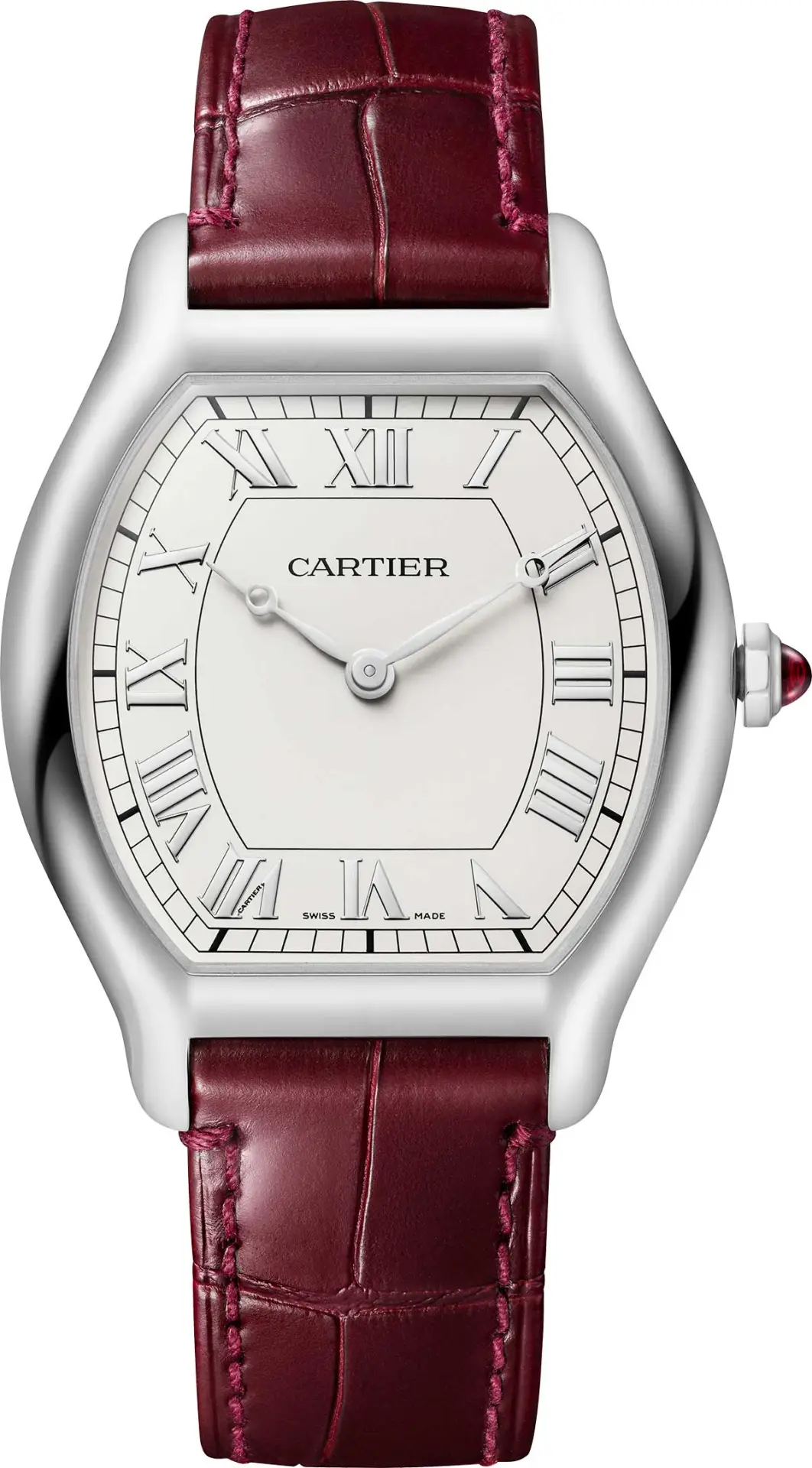
Indeed, the Parisian horological roots run deep, but it’s not all Cartier. From Louis Erard’s whimsical collaboration with French interior-designer-turned-watchmaker Alain Silberstein to the dreamy, avant-garde designs of Paris-based Trilobe, there’s something for everyone in this mix.
Of all the watches Cartier introduced at Watches and Wonders Geneva this year, the Tortue re-edition was the most talked-about. Even older than the Tank, the tortoise-shaped model (born in 1912) is now available in a monopusher chronograph as well as the simpler “hours and minutes” platinum version shown here. Limited to 200 pieces, the stylish and shapely Tortue, which comes out in September, makes clear that even though Cartier manufactures all of its watches in Switzerland, the Paris-based brand is French to its core. $54,770.
Breguet Classique Double Tourbillon “Quai de l’Horloge” 5345
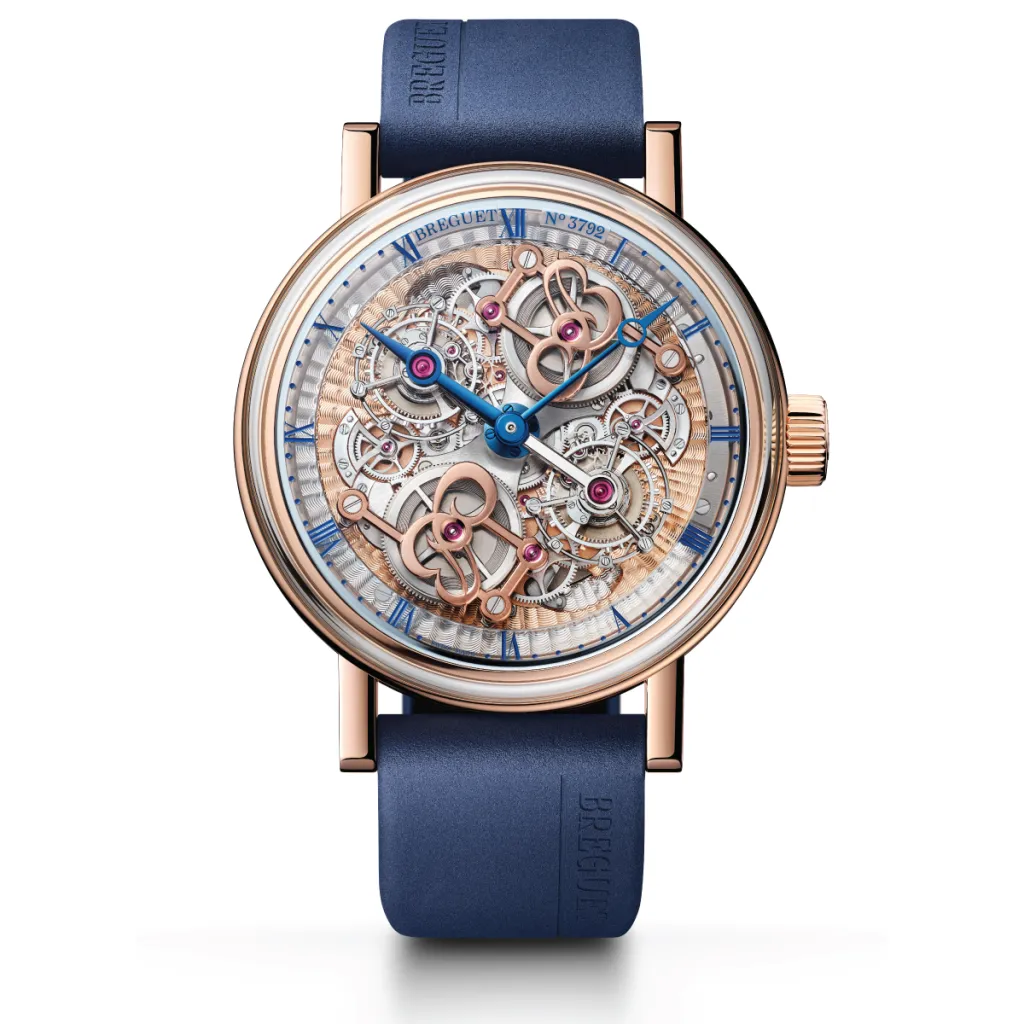
Although Breguet is now based in Switzerland, its namesake, Abraham-Louis Breguet, inventor of the tourbillon as well as the now-ubiquituous Breguet hands and numerals, made his mark on horology in Paris, where he maintained a workshop at 39 Quai de l’Horloge. The brand pays tribute to that history with its latest tourbillon, a 46 mm rose gold wristwatch equipped with not one, but two of the whirling mechanisms. Be sure to admire the engraving on the back of the movement, which depicts an aerial view of the workshop. C’est magnifique! Price on request.
Trilobe Les Matinaux L’Heure Exquise Dune Edition
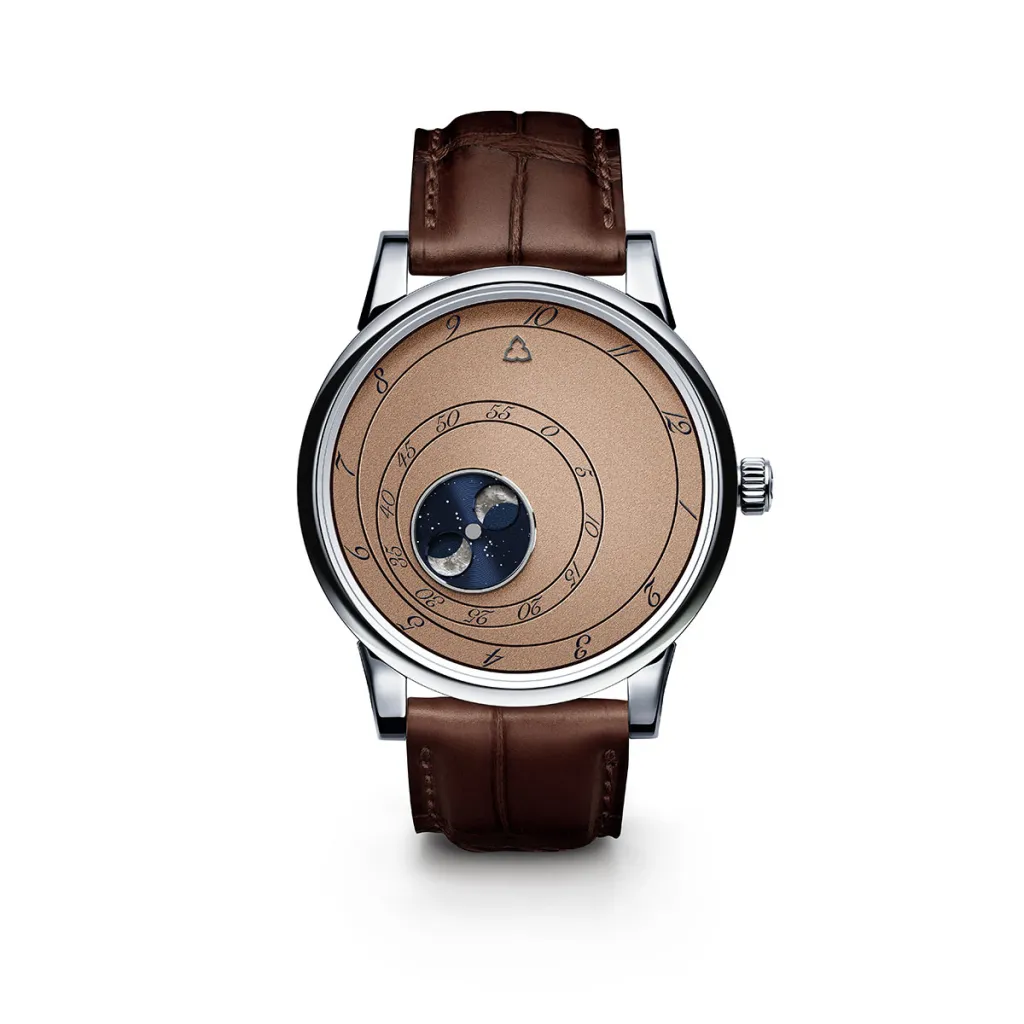
In 2018, Paris-based Trilobe introduced its Les Matinaux (“The Morning”) collection, and with it, a new way of telling the time. Employing a wandering display, the watch used three discs that rotated counterclockwise and three fixed pointers to indicate the hours, minutes and seconds. Named after a collection by the midcentury French poet René Char, the series recently spawned a new sand-colored Dune edition that marks the brand’s entrée into the world of complications. Limited to 100 pieces, the model, dubbed L’Heure Exquise (“The Exquisite Hour”), features a moonphase complication that evokes the orbit of the Moon around the Earth against the backdrop of a starry night sky. $21,995
Chanel Monsieur de Chanel Édition Superleggera Intense Black
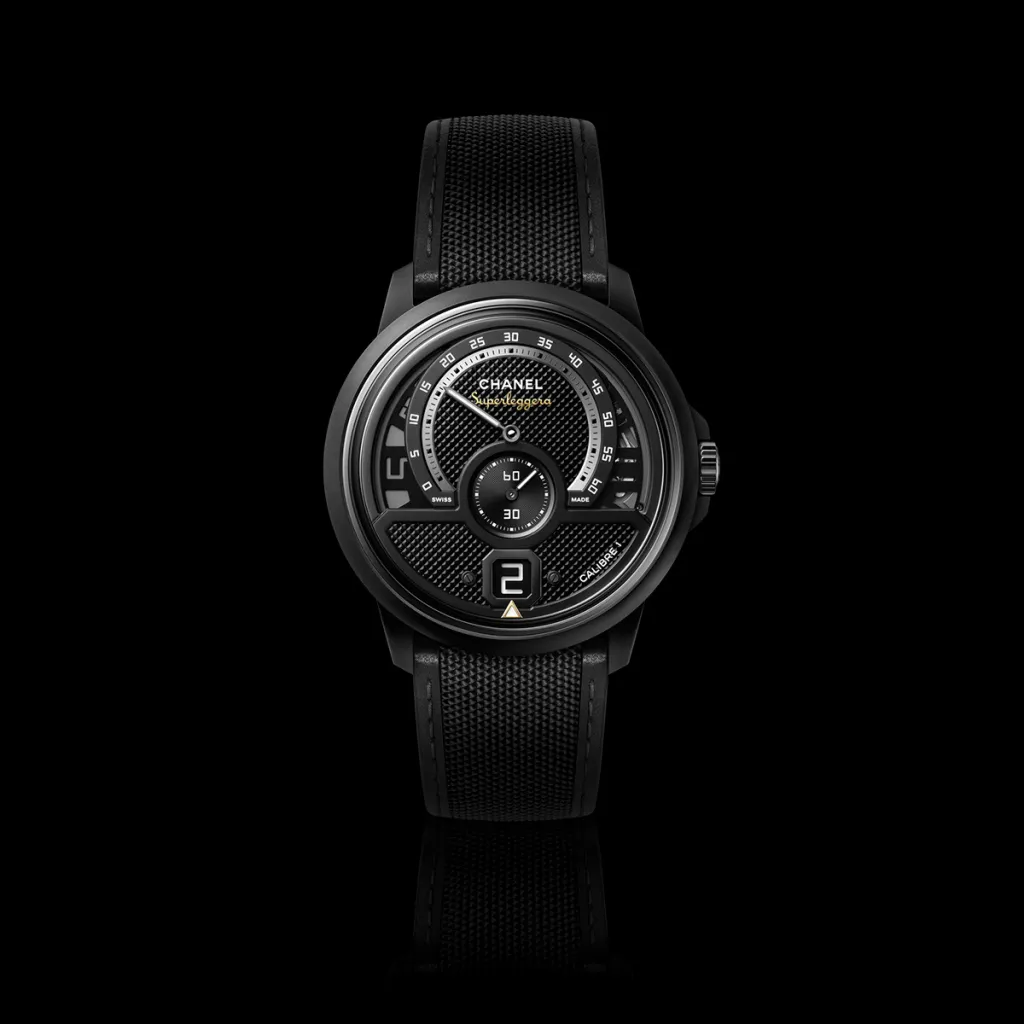
Arguably the Frenchiest brand on our list, Chanel made a name for itself as a high-end (as opposed to fashion) watchmaker in 1999, when it introduced its signature timepiece, the J12 (in unusual-for-the-time ceramic, no less). At Watches and Wonders Geneva in April, the brand upped the ante with its latest Monsieur timepiece, the Superleggera Intense Black, a limited edition of 100 pieces inspired by car racing. Housed in a matte black ceramic and steel case, the watch features a matte black guilloché dial and comes on a black nylon strap with black calfskin leather trim and lining. $69,651
Hermès Arceau Grand Tralala Brides et Mors
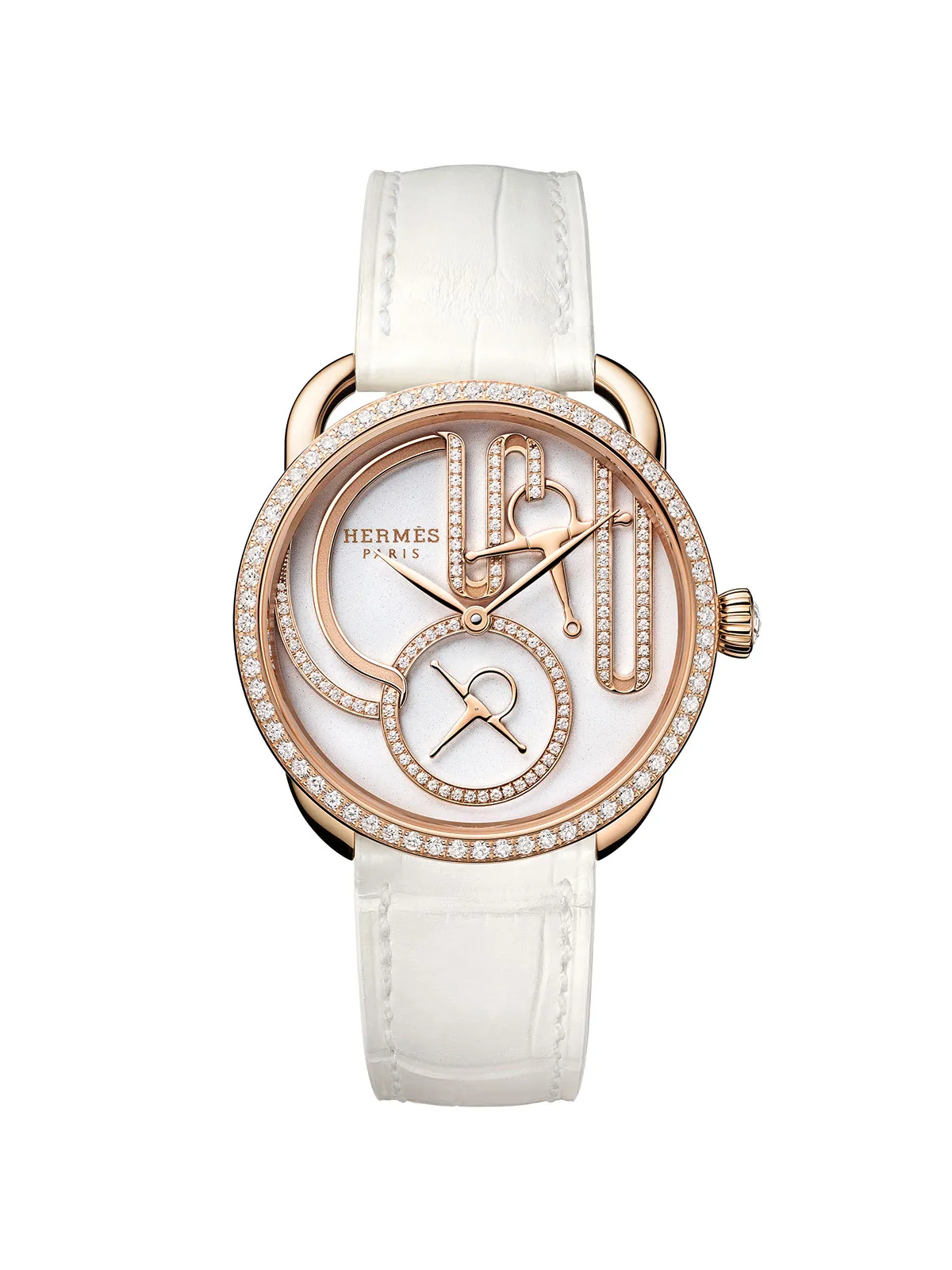
Like so many of Hermès’s most sought-after watches, the new 34 mm Arceau Grand Tralala Brides et Mors traces its design to another Hermès product, in this case the Grand Tralala silk scarf created by French artist Virginie Jamin. Patterned after the prestigious harnesses worn by the Royal Hungarian Bodyguard in the 19th century, the graphic design evokes the look of intertwined bridles and bits within a rose gold frame. Note the bit-shaped seconds hand! $72,172
Louis Erard x Alain Silberstein Smile-Day
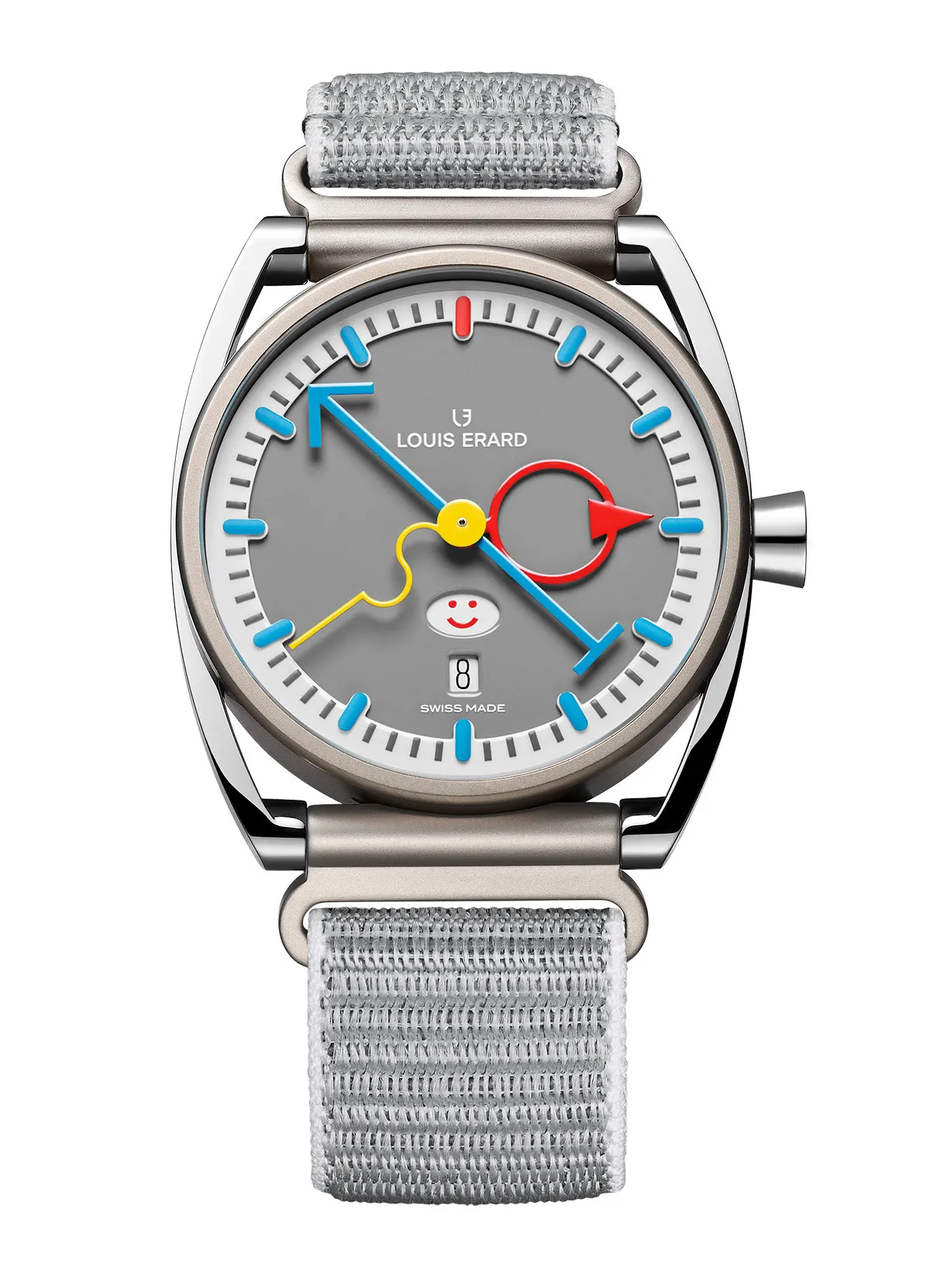
Imagine if Rolex’s much-talked-about emoji watch of 2023 had a child with the Memphis Group, a collective of Milan-based architects and designers who became known in the 1980s for their use of bright primary colors and bold patterns. That’s a quick way to describe the new 40 mm Smile-Day limited edition in titanium from Swiss watchmaker Louis Erard, whose latest collaboration with the iconoclastic French watchmaker Alain Silberstein reflects his signature whimsy. Silberstein was trained in graphic design and architecture in Paris by former members of Germany’s Bauhaus faculty, and he takes his whimsy very seriously. Between the aperture at six o’clock featuring a sliding carousel of seven emojis, the yellow squiggly seconds hand and the nostalgic color scheme, the piece is an instant classic. $8,019
Louis Vuitton Escale
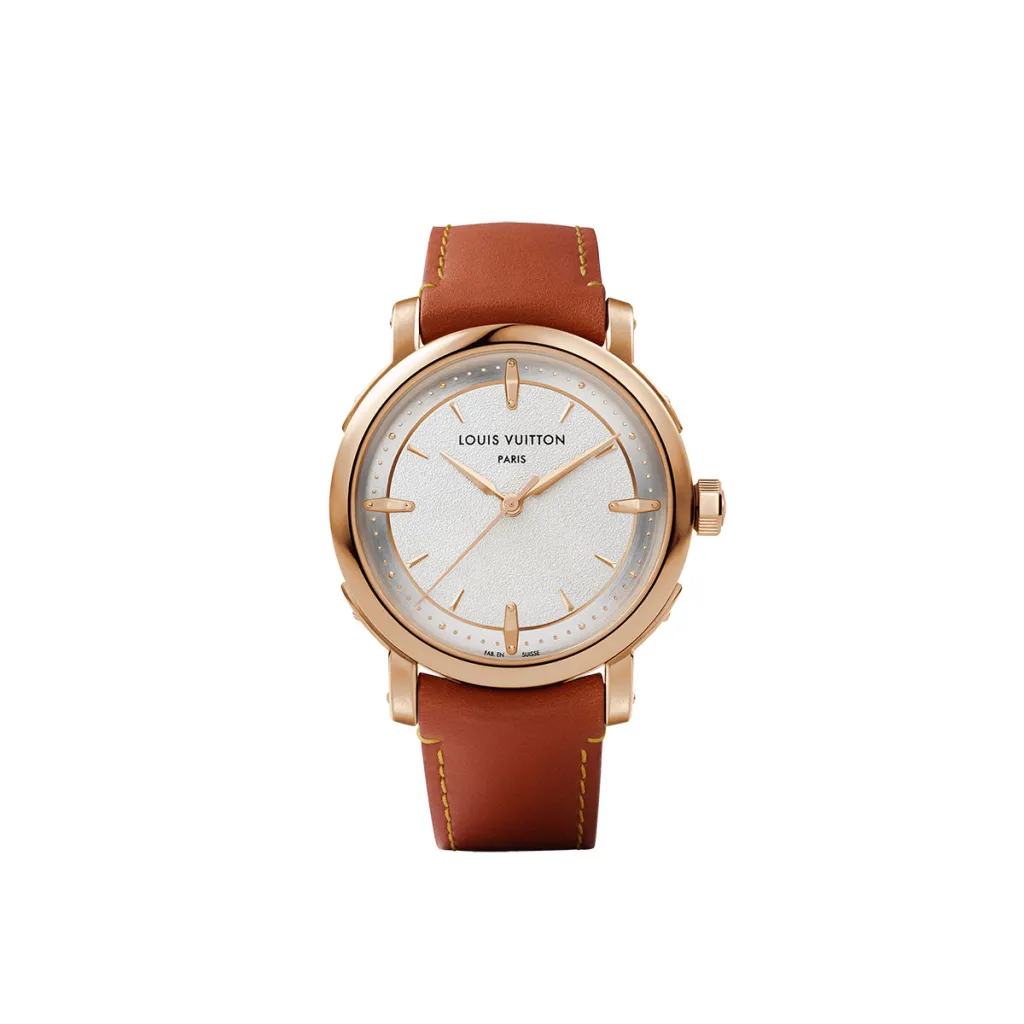
The dress watch revival continues with the new Escale by Louis Vuitton, an elegant timepiece honoring the 10th anniversary of the Escale collection (its first time-only, three-hand watch). Of the four new models in the line, two come in rose gold (like the 39 mm automatic model shown here), while the other two come in platinum. The former feature textured dials designed to evoke the suppleness and tactility of the Louis Vuitton Monogram canvas on metal. Equipped with a chronometer-certified movement with 50 hours of power reserve, the rose-gold Escale comes on a calf-leather strap. In a press release, the brand made sure to emphasize the model’s roots: “Just below the 12 o’clock hour marker, under the Louis Vuitton logo, is one word that encapsulates everything there is to be known about the Escale’s creative rebirth: Paris.” $40,324
Bell & Ross BR 03 Diver Full Lum
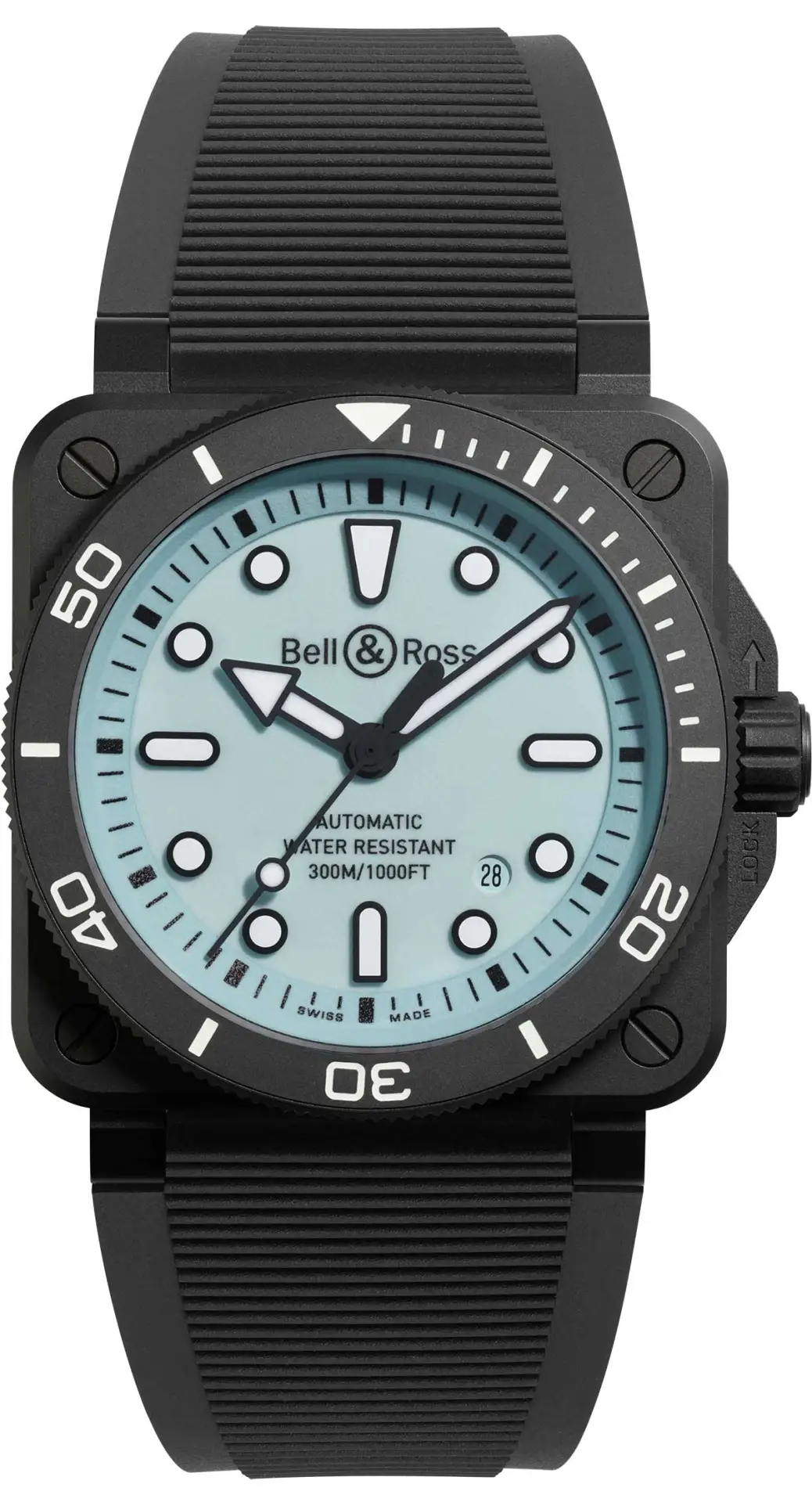
The BR03 Diver from Paris-based Bell & Ross celebrates its seventh anniversary this year. Recognised as the first square diving watch, the 2024 edition is new in more ways than one. Composed of five new models, including the full lume version with a pale blue dial shown here, the series is equipped with an improved automatic movement boasting 54 hours of power reserve, new typography, redesigned hands for optimal legibility and a new adaptable strap. $8,248
You may also like.
How Paris’s Dining, Hotel and Art Scene Got Their Groove Back — Just in Time for the Olympics
The French capital’s cultural life was already on the upswing. Mix in a major global sporting event, and it’s now ready to go toe to toe with any city in the world.
Host cities of modern-day Olympic Games have gotten into the competitive spirit by trying to stage the most spellbinding, over-the-top opening ceremony on record. Beijing enlisted 2008 drummers. London featured James Bond escorting Queen Elizabeth II. All Rio needed to wow the crowd was Gisele, who turned the stadium into her personal catwalk, strutting the length of the field solo. But only Paris could make the unprecedented gamble that the city itself is spectacular enough to be the star of the show.
If all goes according to plan when the Summer Olympics alight in Paris this July, the opening ceremony will play out like a Hollywood epic: timed to coincide with the sinking of the sun, an open-air flotilla of boats will ferry the athlete delegations on the Seine, sailing toward the sunset as hundreds of thousands of spectators cheer from either side of the river’s banks and the bridges above, all bathed in the amber afterglow.
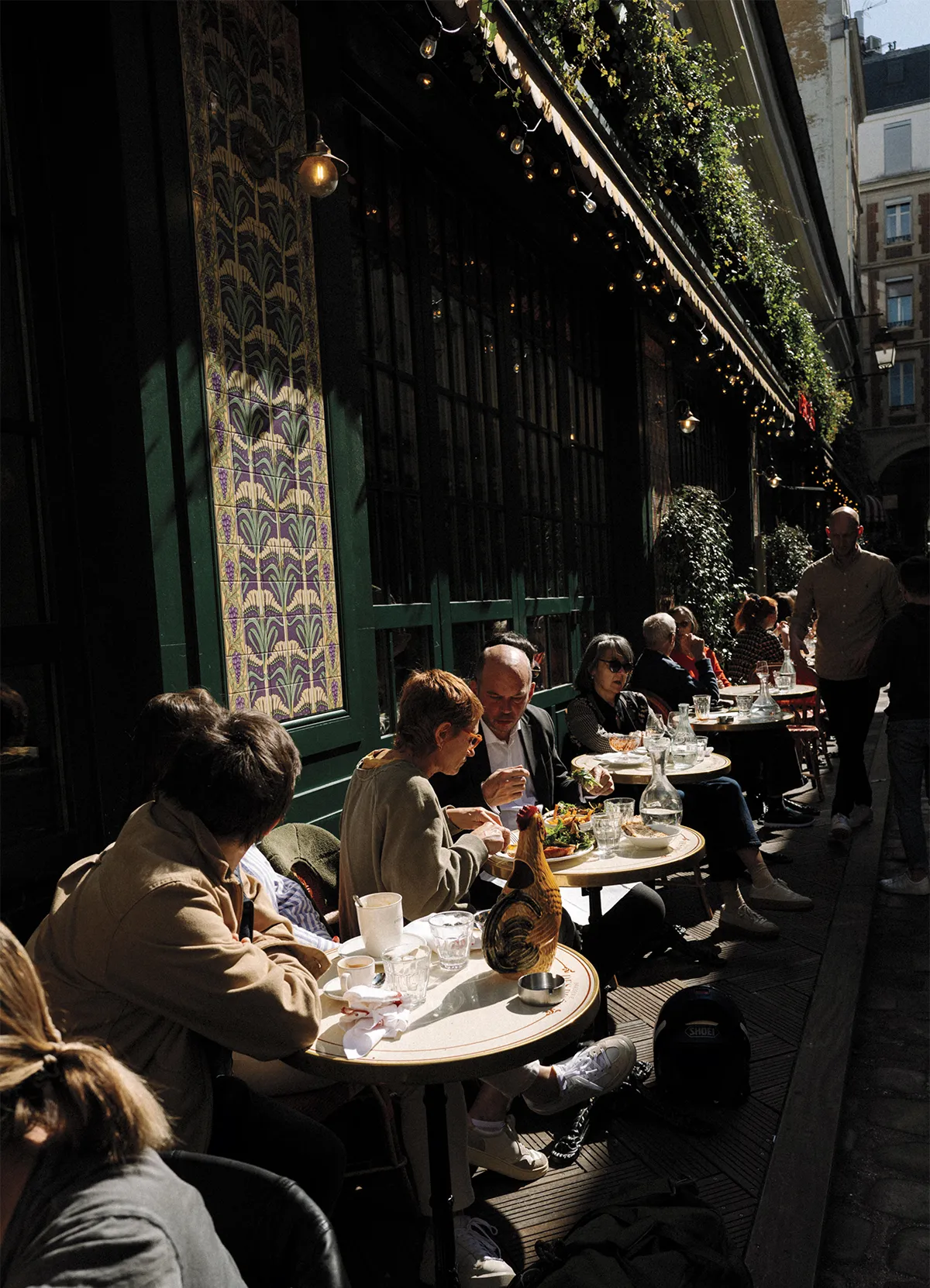
Nico Therin
It will mark the first time the ceremony will be held outside a stadium, let alone on a waterway. So too many of the events themselves, instead of being mounted in mostly generic stadiums on the outskirts of the city, will take place in the heart of Paris, reframing the French capital in a way that locals and visitors alike have never experienced—and that’s sure to dial up the promise of pageantry and emotion.
The Eiffel Tower’s latticed silhouette will serve as the backdrop for beach volleyball at Champs de Mars. Place de la Concorde, where more than a thousand people (including Louis XVI and Marie Antoinette) had their heads lopped off during the French Revolution, will be the site of newly admitted Olympic sports such as skateboarding and breakdancing. And though Olympic swimmers have raced in pools since 1908, this year’s athletes are slated to compete in the river itself. (Competitions will also take place in cities across France, from Lyon to Marseille, and Tahiti in French Polynesia will host the surfing event.)
The specs are ambitious and inventive, and in some ways could restore the city’s reputation for audacity. Because while the City of Light may be known as the cradle of fashion, culture and gastronomy, not too long ago it was also regularly accused of slipping into a lazy, even smug, complacency—stuck in its ways, resting on the laurels of its storied past.
In the food world, those doldrums translated into controversial snubs from the influential World’s 50 Best Restaurants list, known for flushing out avant-garde chefs. The French Michelin Guide, once considered the ultimate arbiter of fine dining, suddenly seemed staid and irrelevant. London and Berlin took Europe’s centre stage in art and design. Even President Emmanuel Macron described his fellow countrymen as resistant to change, much to the ire of those fellow countrymen—and countrywomen.

But influential creatives and Parisians say that in the years leading up to the Games, and particularly since the pandemic, something has shifted. “I really think that during the last 10 years, Paris opened itself to more new things, for different trends,” says Hélène Darroze, the acclaimed chef whose six restaurants include Michelin two-star Marsan in Paris and her three-star namesake at The Connaught in London. “Paris is happier than before, more joyful than before.”
There’s a giddy sense of anticipation, says the illustrator Marin Montagut, who has collaborated with Le Bon Marché and the Ritz Paris and owns an eponymous boutique in Saint-Germain-des-Prés where he sells hand-painted glassware and porcelain decor. “It feels like Paris is trying to look very, very pretty for a very important evening. She’s been getting some plastic surgery and is trying to get ready in time,” he says with a chuckle. “There’s just a lot of effervescence in the city.”
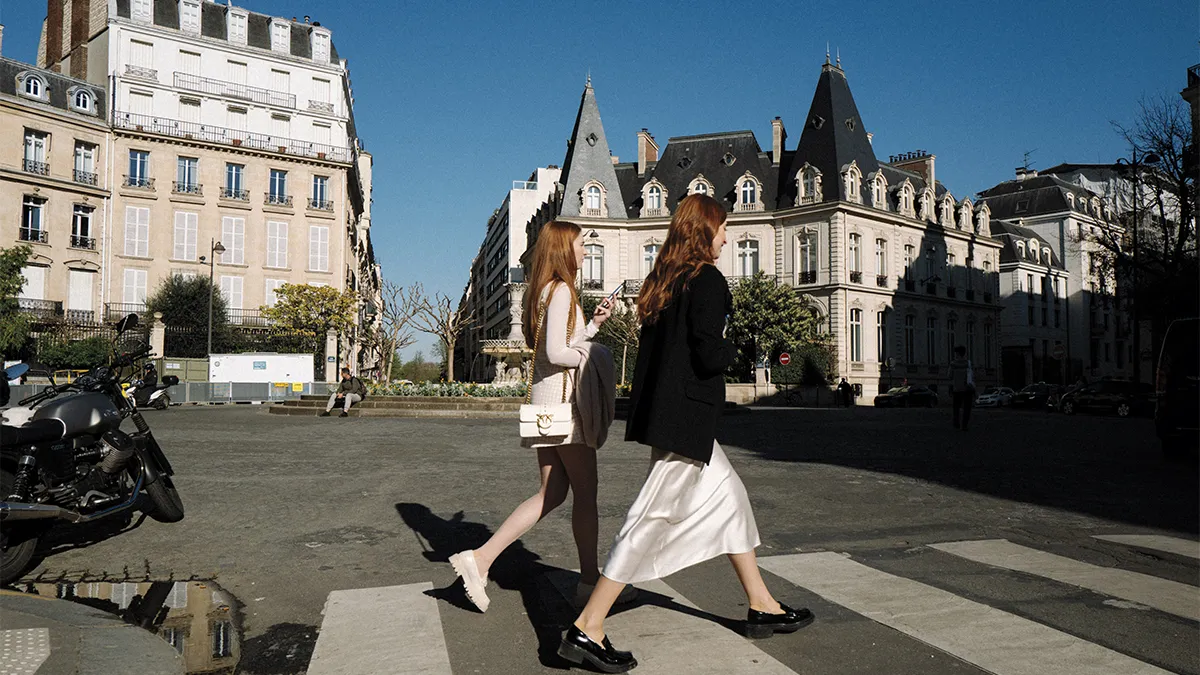
Nico Therin
For better or for worse, some of the credit for that renewed vitality belongs to the light-as-soufflé Netflix series Emily in Paris, which quickly became the collective escapist fantasy for viewers around the world who were grounded by the Covid-19 virus. Another part of that newfound energy, though, can be traced to the frenzied building of luxury hotels, restaurants, galleries, museums and boutiques over the past few years, including Montagut’s own Paris-themed shop, which he opened in 2020.
In the past three years alone, 25 new five-star hotels debuted across the city, bringing the total to 101. Noteworthy newcomers include Madame Rêve, Kimpton St. Honoré Paris, Château des Fleurs, Maison Proust, LVMH’s Cheval Blanc Paris, and Chopard’s first boutique hotel here, 1 Place Vendôme. The dual autumn 2023 openings of Le Grand Mazarin and La Fantaisie hotels marked the Paris debut of Swedish designer Martin Brudnizki, whose playfully modern, maximalist and flamboyant aesthetic injected colour and character into Paris’s elite hotel scene.
In parallel with the growth of traditional hotels, new players in the luxury rental market are emerging, joining the likes of Le Collectionist and Belles Demeures. Founded in 2020, Highstay rents out luxury serviced apartments equipped with kitchens and living spaces. The firm’s current portfolio includes 36 apartments in areas such as the Champs-Élysées and Saint-Honoré, and another 48 are under construction—all of which it owns. There is no check-in (guests are sent digital access codes) and all concierge requests, including housekeeping and travel reservations, are made via live chat on a dedicated guest portal. “The goal is that guests get the real Parisian experience and feel like an insider, like a city dweller,” says general director Maxime Lallement.
The idea of making Paris as welcoming as a second home is also what drives the luxury real-estate market for foreign buyers, particularly Americans, says Alexander Kraft, CEO of Sotheby’s International Realty France-Monaco. He sees 2024 as a “transition year” and says that the local market is moving at two different speeds: while demand for properties between roughly $1.5 million and $8.5 million has cooled, high-end properties between about $17 million and $85 million continue to sell fast among buyers from the Middle East. Kraft predicts the market will pick up in 2025 following the US presidential election. “Paris is one of those real-estate markets that is eternally popular,” he says. “Contrary to other international cities, it really has broad appeal.”
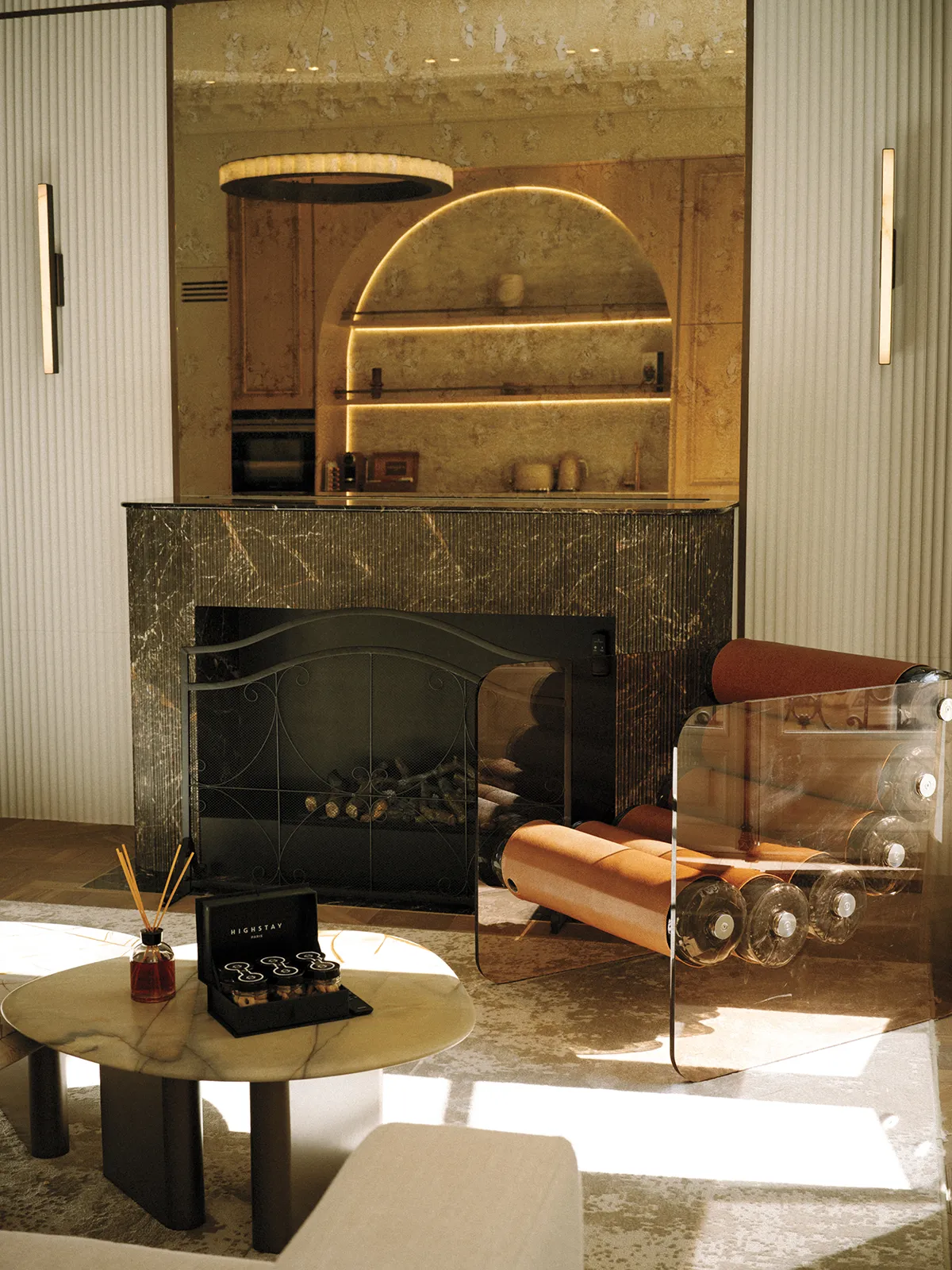
Nico Therin
Montreal-born, New York–based interior designer Garrow Kedigian is one of those frequent visitors who decided to take the leap and buy his own pied-à-terre in Paris a few years ago, after a lifetime of travelling back and forth for both work and pleasure.
As a part-time resident, Kedigian says he too has noticed a palpable shift in the city’s vibe, which he attributes to a renewed appreciation for tourists following their absence during the pandemic, as well as an “international flair” that has given the city a fresh spark. “There’s a lot more cultural diversity than there was before,” he says. “In that respect it’s a bit like New York. And I think that now the interface between Paris’s unique flavour and the international populace is a little bit smoother.”
For Montagut, one of the best examples of this synergy can be found in Belleville, in the city’s east end, where independent artists, musicians and other urban creatives rub shoulders in Chinese, African, and Arab restaurants and businesses. “There’s a social and cultural diversity here, and for me this is really important,” Montagut says. “If Paris was just the 6th arrondissement, it would be boring.”
The eastern edge of Paris is also one of the preferred neighbourhoods of Michael Schwartz, the marketing and communications manager for Europe at French jewellery house Boucheron. A recent New York City transplant, he is drawn to the burgeoning number of gastronomic gems far from the madding tourist crowds.
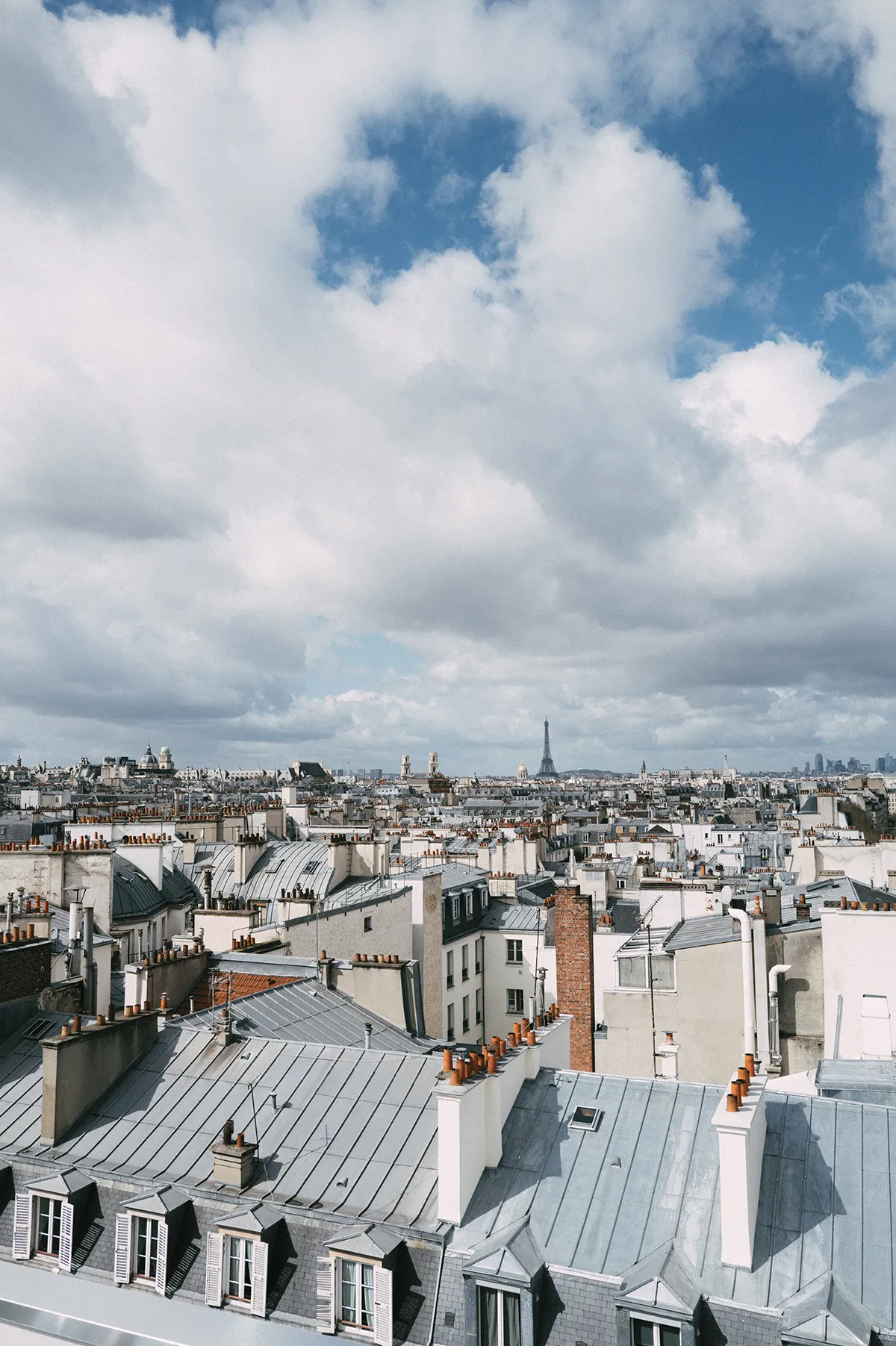
Nico Therin
He points to sister restaurants Caché and Amagat (the names mean “hidden” in French and Catalan, respectively), discreetly located at the end of a cobblestoned cul-de-sac, as favourites. With backgrounds in fashion and advertising, the Italian duo who run them have attracted equally fashionable locals to this hitherto quiet part of town. Caché serves up fresh Mediterranean seafood dishes, while next door, Amagat specialises in Catalan tapas.
Then there’s Soces, a corner seafood bistro on rue de la Villette, where you might find Jean-Benoît Dunckel, who co-wrote the score to Sofia Coppola’s film The Virgin Suicides when he was part of the electronic-music duo Air (Dunckel’s recording studio is in the area), or the French designers behind the Coperni fashion line, Sébastien Meyer and Arnaud Vaillant. “This is a really special restaurant,” says Schwartz. “It’s frequented by really cool creatives, designers and musicians, and it’s kind of a destination restaurant for most people because it’s not central.”
What makes Paris’s dining scene so exciting now, according to Stéphane Bréhier, editor in chief of French restaurant guide Gault& Millau, is a sense of fearlessness among younger chefs who reject the traditional trajectory that begins with a lowly stage in a Michelin-star kitchen. What’s more, visitors are likewise foregoing Michelin establishments in favour of newer, more experimental dining spots. “Over the last few years, there’s been a profusion of young chefs who don’t want to work for other people and are daring to set up their own shop,” Bréhier says. “The gastronomic scene is booming in Paris.”
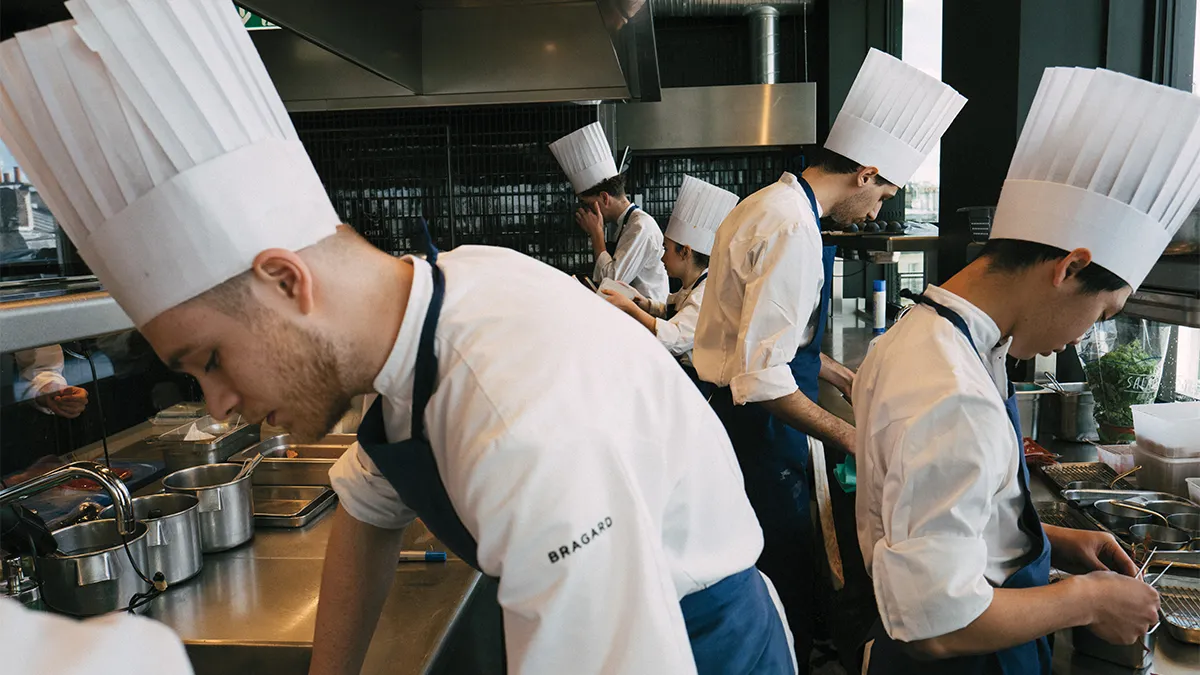
Nico Therin
These bold, emerging chefs feel less bound not only to their elders but also to French cuisine itself. “It has changed a lot,” says Hélène Darroze, who opened Marsan, her first Parisian restaurant, 25 years ago. “The new generation travelled a lot—in South America, for example, in Asia—before opening a restaurant or being a head chef somewhere. They opened themselves to other cultures. This is why the culinary scene at the moment is very interesting in Paris; because it’s a mix of very famous chefs with Michelin stars but also young chefs who don’t care about Michelin stars—they just want to explore so many fields.”
The ever-growing importance of social media and its insatiable hunger for envy-inducing images is driving another major trend in the dining scene: rooftop spots, including Mun and Girafe in the Golden Triangle, the area bordered by avenues Montaigne and George V and the Champs-Élysées. “A lot of rooftops have opened in Paris, where before they were pretty much nonexistent apart from the Eiffel Tower and the Montparnasse Tower,” says Dimitri Ruiz, head concierge at Hôtel Barrière Fouquet’s Paris on the Champs-Élysées.
Five-star Right Bank hotels SO/ and Cheval Blanc Paris have watering holes that offer sweeping vistas of the Seine. But perhaps the most coveted perch during the opening ceremony will be the Champagne bar at La Tour d’Argent restaurant, which boasts unobstructed views of the Notre-Dame Cathedral and the Seine. (And yes, someone already had the idea to book it for a private event.) Famous for its signature pressed duck as well as for hosting monarchs and heads of state, the historic restaurant recently underwent a major renovation that included the addition of the aerie, which opened late last summer. “It’s only been in the last 10 years or so that Paris has been developing rooftops, and it’s really taking off like wildfire,” says third-generation owner André Terrail.
Paris’s venerated fashion industry has also found ways to innovate, with fresh faces keeping their fellow couturiers on their toes and the shopping options enticing. In 2022, for example, Simon Porte Jacquemus opened his first boutique in the city on avenue Montaigne—home to Gucci, Chanel, and Prada, among other venerable names—and in March, at the age of 34, became France’s youngest fashion designer to be named a Chevalier de l’Ordre des Arts et des Lettres for his contributions to the field. That kind of success has a ripple effect in the creative community.
“Almost every street has the name of an artist or a politician,” says Charaf Tajer, the Parisian-born creative director behind the London-based Casablanca sportswear line. “So the city reminds me always that the people who came before me, who walked those streets, created the future in a way. As much as [Paris] seems stuck in time visually, you can also feel the energy of people creating the present.”
Interior designer David Jimenez, whose 2022 book Parisian by Design compiles his Francophile projects, moved to the city in 2015 and spent his first few years living near the Champs-Élysées, which he says has undergone a noticeable revival. Along with Jacquemus’s arrival, new luxury openings or expansions—including Burberry, Saint Laurent, Bottega Veneta, and Panerai—and city-led greening efforts are bringing Parisians back to the 8th arrondissement, long dismissed as an overcrowded tourist trap where fast-food and fast-fashion chains had colonised the once glamorously luxe avenue. Now, Dior’s captivating Peter Marino–designed museum draws legions of fans, while the city has been busy planting more trees, renovating gardens and repairing damaged sidewalks as part of a long-term embellishment plan. And on the first Sunday of every month, the entire length of the Champs-Élysées becomes a pedestrian-only promenade. “It’s an exciting evolution in a part of the city that seemed sleepy and perhaps lost its way a little bit,” Jimenez says. “Now there’s a thrust forward.”
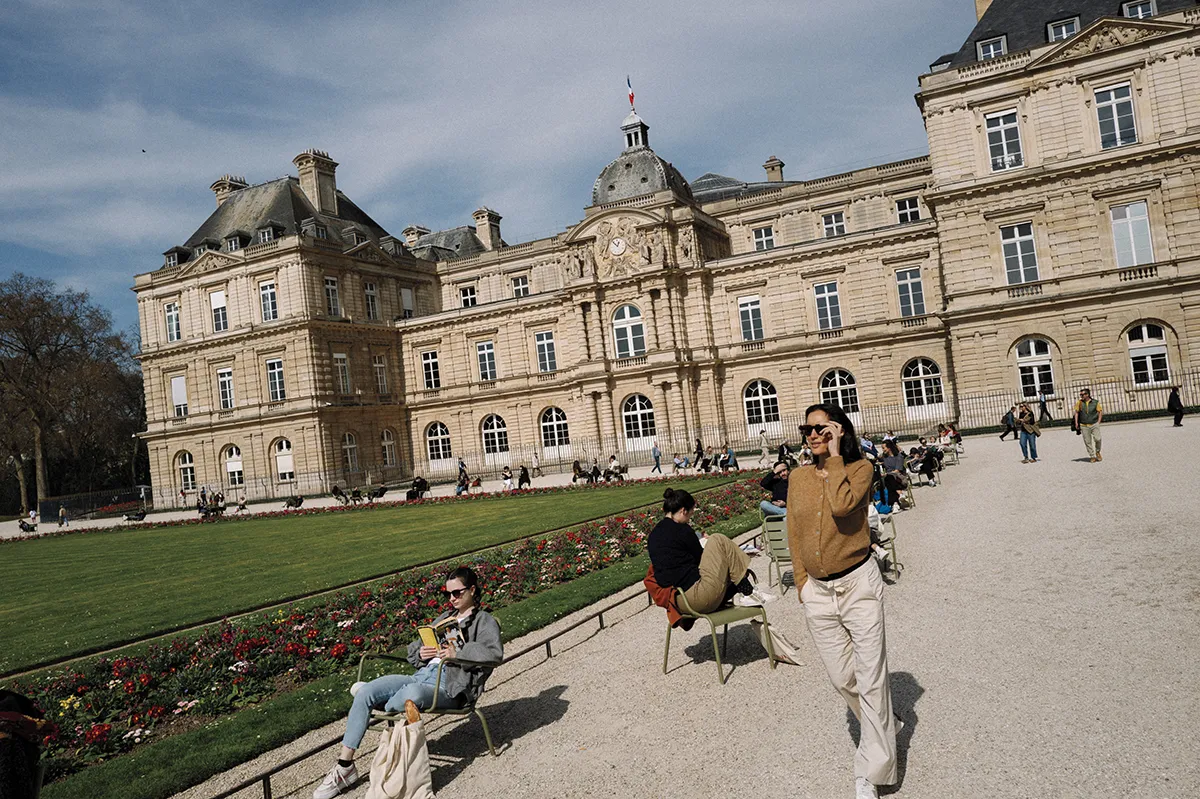
Nico Therin
The thriving fashion houses are responsible for more than maintaining the city’s unparalleled reputation for chic. To a large degree, they have also helped revive its status as an art capital. The billions generated by LVMH (parent of Louis Vuitton, Dior and Berluti, among others) and Kering (Alexander McQueen, Gucci, Bottega Veneta, et al.) funded the extraordinary contemporary art collections amassed by their founders, Bernard Arnault and François Pinault, respectively. The rivals rewarded their hometown with two museums, Fondation Louis Vuitton and Bourse de Commerce, that have helped make it a leader in contemporary art.
Also lending a hand: Brexit, which persuaded many international galleries to brush up on their French. One of the most talked-about recent additions is the powerhouse Hauser & Wirth, which opened in a 19th-century hôtel particulier near the Champs-Élysées last year. David Zwirner arrived in 2019, Mariane Ibrahim in 2021, and Peter Kilchmann the following year, all joining long-established Parisian galleries including Perrotin and Thaddaeus Ropac. The City of Light even snagged its own coveted annual installment of Art Basel: Paris+, which now runs every October in the Grand Palais.
“Quite frankly, Paris has been putting up some of the most incredible exhibitions in institutions in Europe,” says Serena Cattaneo Adorno, senior director at Gagosian. “And a lot of private collectors have also decided to open spaces in the city, creating a great dynamic between public and private galleries.”

The always-savvy Gagosian, on rue Ponthieu, has hit upon an authentic tie-in with the Games: a summer exhibition featuring Olympic posters created over the years by celebrated artists from Picasso on up to Warhol, Hockney and Tracey Emin. “Once you start digging, you find that a lot of artists have reflected on sports and the engagement of the body,” Cattaneo Adorno says. “It’s just a really pure and beautiful message about how art and sports have dialogues that can be somewhat surprising.”
A few months out from the festivities on the Seine, interior decorator Jimenez sums up the mood of many locals, saying (only half-jokingly), “I think for most Parisians, there’s a sense of curiosity, optimism, excitement—and an exit plan, in that order.”
While polling shows that nearly half of Parisians intend to vacate the city during the games, Jimenez notes that he will be watching the opening ceremony with friends who live in an apartment overlooking the Seine. “I want to be part of the excitement. I want to see as much as I can and be energised by this very special and unique moment,” he says. “It’s a once-in-a-lifetime opportunity, and I am deeply grateful to be able to experience it first-hand as an American living in Paris.”
Additional reporting by Lucy Alexander and Justin Fenner.
You may also like.
Watches & Wonders 2024 Showcase: Hermès
We head to Geneva for the Watches & Wonders exhibition; a week-long horological blockbuster featuring the hottest new drops, and no shortage of hype.
With Watches & Wonders 2024 well and truly behind us, we review some of the novelties Hermès presented at this year’s event.
—
HERMÈS
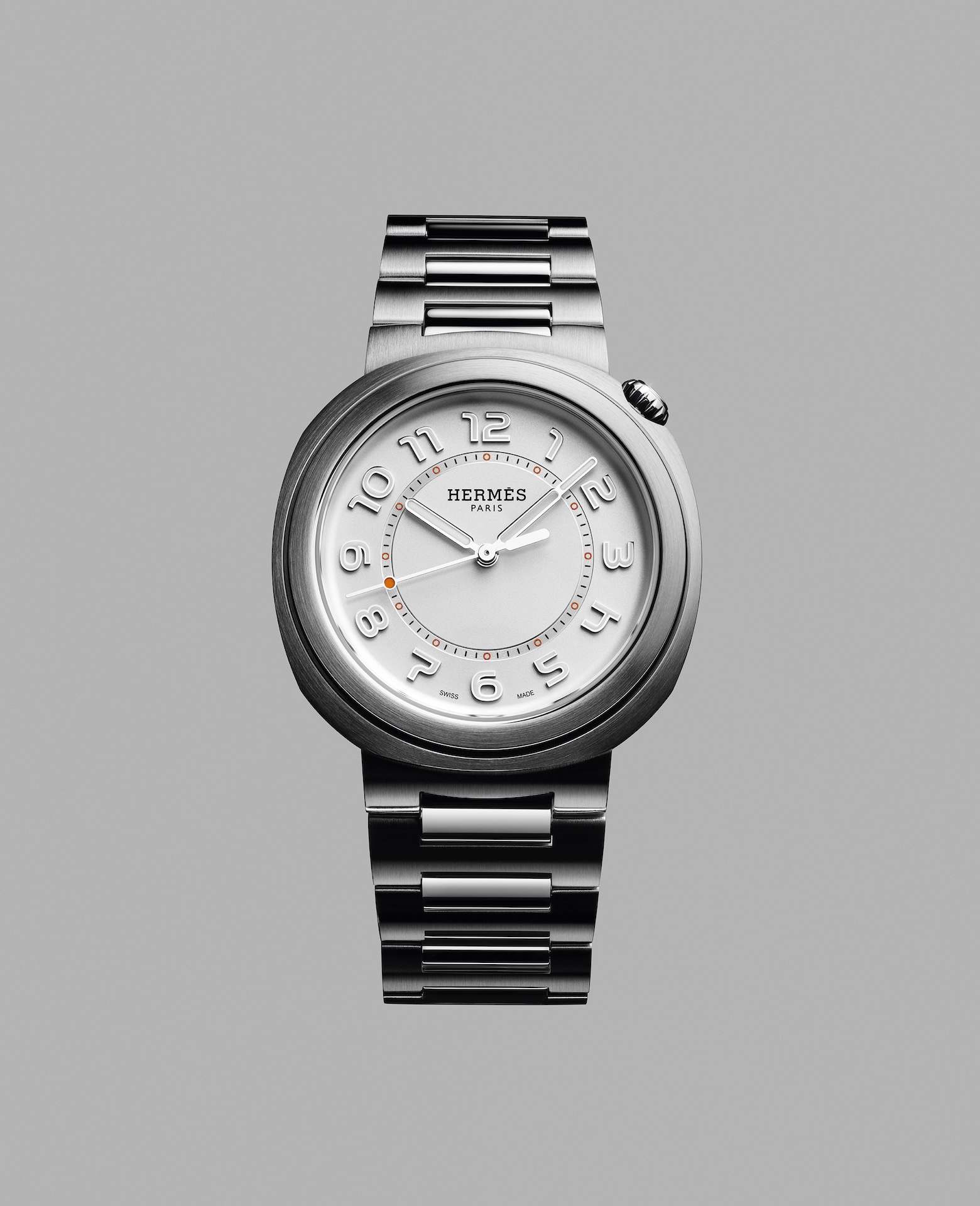
Moving away from the block colours and sporty aesthetic that has defined Hermès watches in recent years, the biggest news from the French luxury goods company at Watches & Wonders came with the unveiling of its newest collection, the Hermès Cut.
It flaunts a round bezel, but the case middle is nearer to a tonneau shape—a relatively simple design that, despite attracting flak from some watch aficionados, works. While marketed as a “women’s watch”, the Cut has universal appeal thanks to its elegant package and proportions. It moves away from the Maison’s penchant for a style-first product; it’s a watch that tells the time, not a fashion accessory with the ability to tell the time.
Hermès gets the proportions just right thanks to a satin-brushed and polished 36 mm case, PVD-treated Arabic numerals, and clean-cut edges that further accentuate its character. One of the key design elements is the positioning of the crown, boldly sitting at half-past one and embellished with a lacquered or engraved “H”, clearly stamping its originality. The watch is powered by a Hermès Manufacture movement H1912, revealed through its sapphire crystal caseback. In addition to its seamlessly integrated and easy-wearing metal bracelet, the Cut also comes with the option for a range of coloured rubber straps. Together with its clever interchangeable system, it’s a cinch to swap out its look.
It will be interesting to see how the Hermès Cut fares in coming months, particularly as it tries to establish its own identity separate from the more aggressive, but widely popular, Ho8 collection. Either way, the company is now a serious part of the dialogue around the concept of time.
—
Read more about this year’s Watches & Wonders exhibition at robbreport.com.au
You may also like.
Watch This Space: Mike Nouveau
Meet the game-changing horological influencers blazing a trail across social media—and doing things their own way.
In the thriving world of luxury watches, few people own a space that offers unfiltered digital amplification. And that’s precisely what makes the likes of Brynn Wallner, Teddy Baldassarre, Mike Nouveau and Justin Hast so compelling.
These thought-provoking digital crusaders are now paving the way for the story of watches to be told, and shown, in a new light. Speaking to thousands of followers on the daily—mainly via TikTok, Instagram and YouTube—these progressive commentators represent the new guard of watch pundits. And they’re swaying the opinions, and dollars, of the up-and-coming generations who now represent the target consumer of this booming sector.
—
MIKE NOUVEAU

Can we please see what’s on the wrist? That’s the question that catapulted Mike Nouveau into watch stardom, thanks to his penchant for highlighting incredibly rare timepieces across his TikTok account of more than 400,000 followers. When viewing Nouveau’s attention-grabbing video clips—usually shot in a New York City neighbourhood—it’s not uncommon to find him wrist-rolling some of the world’s rarest timepieces, like the million-dollar Cartier Cheich (a clip he posted in May).
But how did someone without any previous watch experience come to amass such a cult following, and in the process gain access to some of the world’s most coveted timepieces? Nouveau admits had been a collector for many years, but moved didn’t move into horology full-time until 2020, when he swapped his DJing career for one as a vintage watch specialist.
“I probably researched for a year before I even bought my first watch,” says Nouveau, alluding to his Rolex GMT Master “Pepsi” ref. 1675 from 1967, a lionised timepiece in the vintage cosmos. “I would see deals arise that I knew were very good, but they weren’t necessarily watches that I wanted to buy myself. I eventually started buying and selling, flipping just for fun because I knew how to spot a good deal.”
Nouveau claims that before launching his TikTok account in the wake of Covid-19, no one in the watch community knew he existed. “There really wasn’t much watch content, if any, on TikTok before I started posting, especially talking about vintage watches. There’s still not that many voices for vintage watches, period,” says Nouveau. “It just so happens that my audience probably skews younger, and I’d say there are just as many young people interested in vintage watches as there are in modern watches.”
View this post on Instagram
Nouveau recently posted a video to his TikTok account revealing that the average price of a watch purchased by Gen Z is now almost US$11,000 (around $16,500), with 41 percent of them coming into possession of a luxury watch in the past 12 months.
“Do as much independent research as you can [when buying],” he advises. “The more you do, the more informed you are and the less likely you are to make a mistake. And don’t bring modern watch expectations to the vintage world because it’s very different. People say, ‘buy the dealer’, but I don’t do that. I trust myself and myself only.”
—
Read more about the influencers shaking up horology here with Justin Hast, Brynn Wallner and Teddy Baldassare.
You may also like.
5 Lounge Chairs That Add Chic Seating to Your Space
Daybeds, the most relaxed of seating solutions, offer a surprising amount of utility.
Chaise longue, daybed, recamier, duchesse brisée—elongated furniture designed for relaxing has a roster of fancy names. While the French royal court of Louis XIV brought such pieces to prominence in fashionable European homes, the general idea has been around far longer: The Egyptian pharaohs were big fans, while daybeds from China’s Ming dynasty spurred all those Hollywood Regency fretwork pieces that still populate Palm Beach living rooms. Even Mies van der Rohe, one of design’s modernist icons, got into the lounge game with his Barcelona couch, a study of line and form that holds up today.
But don’t get caught up in who invented them, or what to call them. Instead, consider their versatility: Backless models are ideal in front of large expanses of glass (imagine lazing on one with an ocean view) or at the foot of a bed, while more structured pieces can transform any corner into a cozy reading nook. Daybeds may be inextricably linked to relaxation, but from a design perspective, they put in serious work.
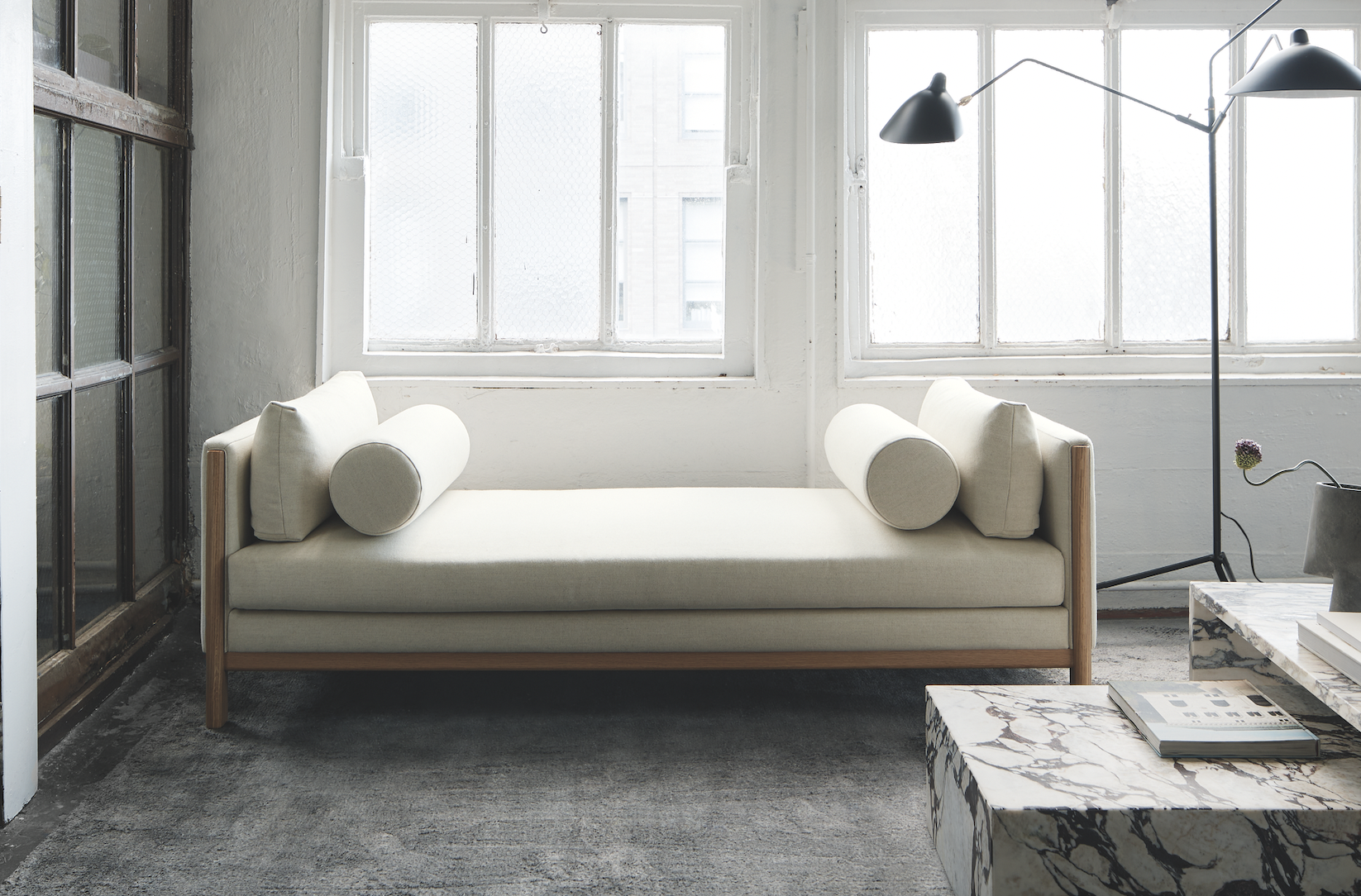
Emmy, Egg Collective
In designing the Emmy chaise, the Egg Collective trio of Stephanie Beamer, Crystal Ellis and Hillary Petrie, who met as students at Washington University in St. Louis, aimed for versatility. Indeed, the tailored chaise looks equally at home in a glass skyscraper as it does in a turn-of-the-century town house. Combining the elegance of a smooth, solid oak or walnut frame with the comfort of bolsters and cushioned upholstery or leather, it works just as well against a wall or at the heart of a room. From around $7,015; Eggcollective.com
 Plum, Michael Robbins
Plum, Michael Robbins
Woodworker Michael Robbins is the quintessential artisan from New York State’s Hudson Valley in that both his materials and methods pay homage to the area. In fact, he describes his style as “honest, playful, elegant and reflective of the aesthetic of the Hudson Valley surroundings”. Robbins crafts his furniture by hand but allows the wood he uses to help guide the look of a piece. (The studio offers eight standard finishes.) The Plum daybed, brought to life at Robbins’s workshop, exhibits his signature modern rusticity injected with a hint of whimsy thanks to the simplicity of its geometric forms. Around $4,275; MichaelRobbins.com

Kimani, Reda Amalou Design
French architect and designer Reda Amalou acknowledges the challenge of creating standout seating given the number of iconic 20th-century examples already in existence. Still, he persists—and prevails. The Kimani, a bent slash of a daybed in a limited edition of eight pieces, makes a forceful statement. Its leather cushion features a rolled headrest and rhythmic channel stitching reminiscent of that found on the seats of ’70s cars; visually, these elements anchor the slender silhouette atop a patinated bronze base with a sure-handed single line. The result: a seamless contour for the body. Around $33,530; RedaAmalou
Dune, Workshop/APD
From a firm known for crafting subtle but luxurious architecture and interiors, Workshop/APD’s debut furniture collection is on point. Among its offerings is the leather-wrapped Dune daybed. With classical and Art Deco influences, its cylindrical bolsters are a tactile celebration, and the peek of the curved satin-brass base makes for a sensual surprise. Associate principal Andrew Kline notes that the daybed adeptly bridges two seating areas in a roomy living space or can sit, bench-style, at the foot of a bed. From $13,040; Workshop/ APD
Sherazade, Edra
Designed by Francesco Binfaré, this sculptural, minimalist daybed—inspired by the rugs used by Eastern civilizations—allows for complete relaxation. Strength combined with comfort is the name of the game here. The Sherazade’s structure is made from light but sturdy honeycomb wood, while next-gen Gellyfoam and synthetic wadding aid repose. True to Edra’s amorphous design codes, it can switch configurations depending on the user’s mood or needs; for example, the accompanying extra pillows—one rectangular and one cylinder shaped— interchange to become armrests or backrests. From $32,900; Edra

















